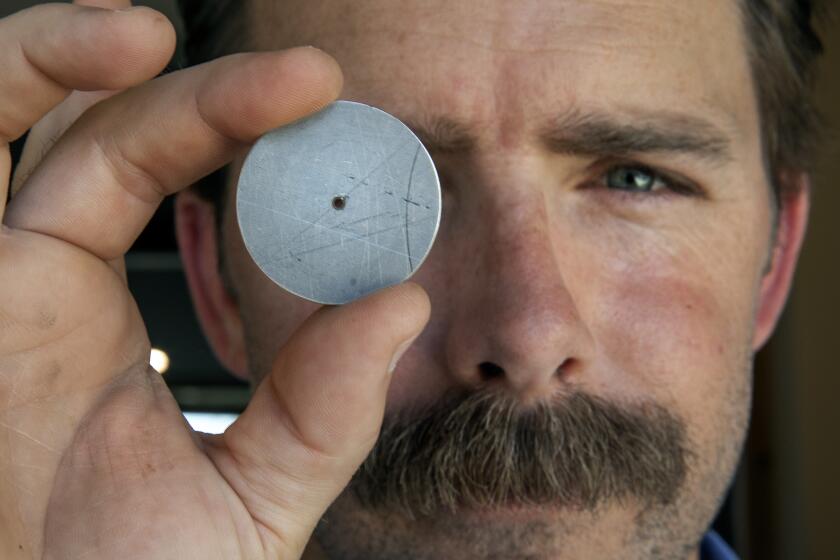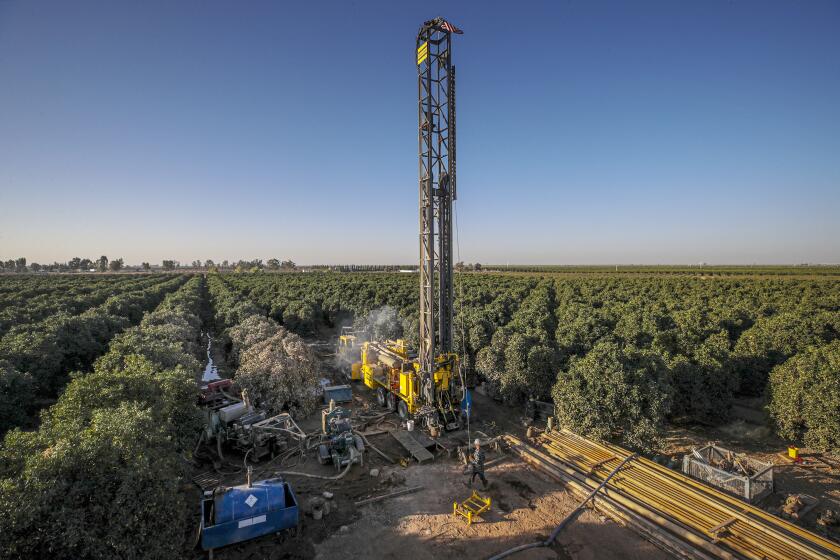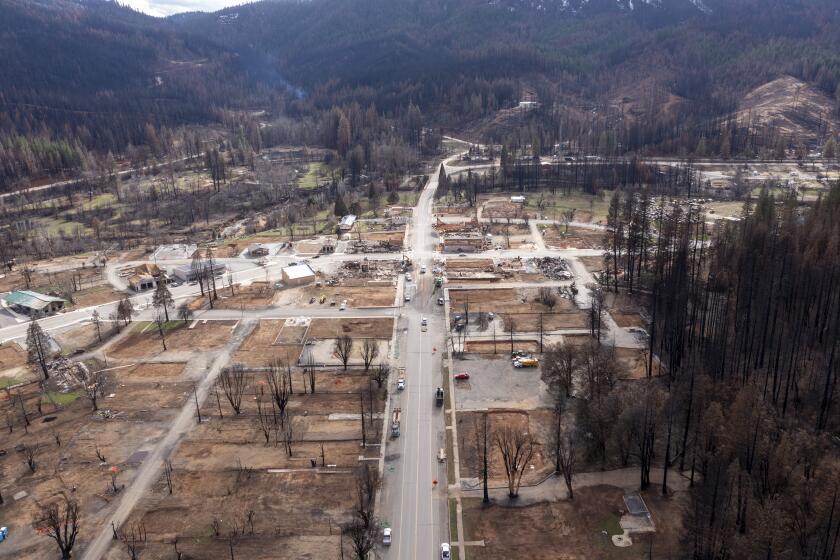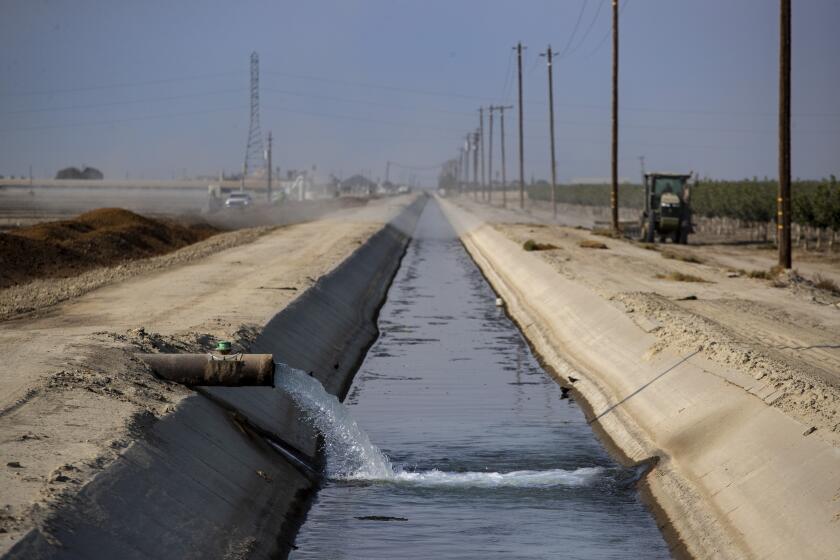Air quality worsens as drought forces California growers to burn abandoned crops
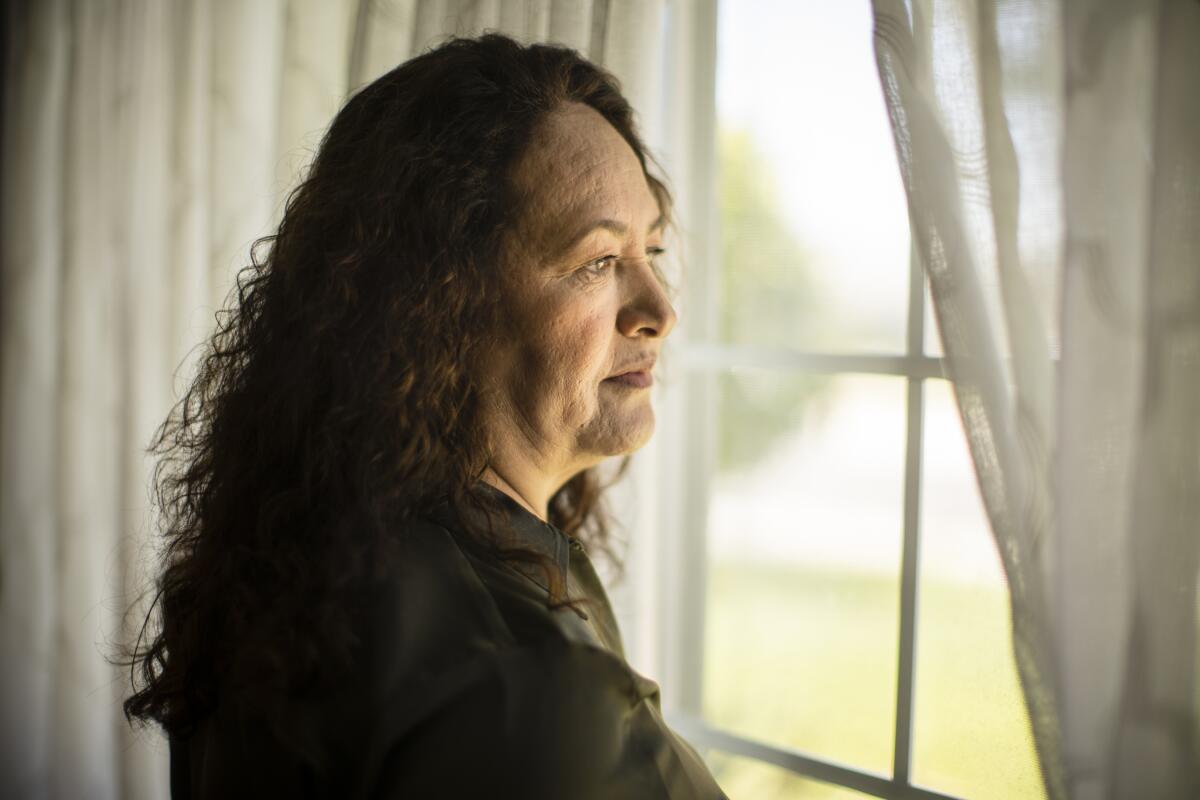
LA VINA, Calif. — Driving to work one gray morning last year, Eduwiges Aguayo stopped suddenly when she saw columns of smoke billowing from burning piles of discarded grapevines.
Aguayo, who had stopped about a mile from her home in San Joaquin Valley’s grape country, called her family to give them a warning: Stay indoors, shut the windows and avoid running the air conditioner since it draws air from outside.
“It looked almost as if it was cloudy, like it was very gray outside,” Aguayo recalled of the ashen haze that surrounded her. “But it wasn’t cloudy. It was air pollution.”
In a region that already suffers from some of the worst particulate pollution in the nation, San Joaquin Valley residents are learning that extreme drought conditions can be as hard on human lungs as they are on local crops.
In one wealthy Los Angeles County enclave, 70% of water is used outdoors. Officials hope to curb chronic overuse with these custom flow restrictors.
With periods of extended dryness and water curtailments occurring more frequently due to climate change, growers in California’s Central Valley — one of the most productive agricultural regions on the planet — are increasingly looking to fallow fields or uproot orchards and vineyards for lack of irrigation. Once gathered into towering pyres, the vegetation is then set ablaze, sending lung- and heart-aggravating haze across the valley.
San Joaquin Valley air regulators have struggled for nearly 20 years to outlaw the practice of agricultural burning, encouraging farmers instead to grind up forsaken crops in wood chippers and spread them as mulch. But amid a third year of drought, some fear a resurgence in large-scale burning because it’s cheaper than grinding, and because so many acres are being abandoned due to drought.
Already, 395,000 acres of farmland have been fallowed across California because of the drought, according to UC Merced research. Industry groups estimate 60,000 acres of almond trees and 15,000 acres of vineyards will be removed statewide this year as well.
“If you’re not able to get water, then you’re gonna have a lot of dry stuff that’s potentially going to die. And then what’s gonna happen with that waste?” asked Catherine Garoupa White, executive director of the Central Valley Air Quality Coalition. “It’s easier to just strike a match and light it on fire.”
A pile of agricultural waste burns in La Vina, Calif. (Eduwiges Aguayo)
Home to more than 4 million people, the San Joaquin Valley has earned an unwelcome reputation as a hot spot for air pollution, due in part to its unique geography.
The region is located at the southern end of the Central Valley — which is wedged between the Sierra Nevada and Coast ranges. These ranges help to trap toxins from auto emissions, oil drilling, wildfire smoke and other sources and allow concentrations to build to unhealthful levels. Although agricultural burning also occurs in the Sacramento Valley to the north, it has been less of an air quality problem.
Each year, Fresno residents withstand about 51 days — more than seven weeks — of unhealthful levels of fine particulate in the air. When inhaled, these fine particles, smaller than the width of a human hair, travel deep into the lungs and into the bloodstream, potentially triggering asthma attacks, heart attacks and strokes.
Over the course of his 30-year career as a physician, Anthony Molina witnessed the effects of San Joaquin Valley air pollution firsthand. He is still haunted by the memory of medical personnel rushing a 16-year-old boy into the emergency room of the Clovis Community Medical Center during an asthma attack on a bad air day. All efforts to resuscitate the teen proved unsuccessful.
“He came in, intubated, but ... his lungs were just clamped down,” Molina recalled. “And so you just couldn’t ventilate him. Trying to pump air into his lungs was like trying to blow up a balloon that would not expand, basically.”
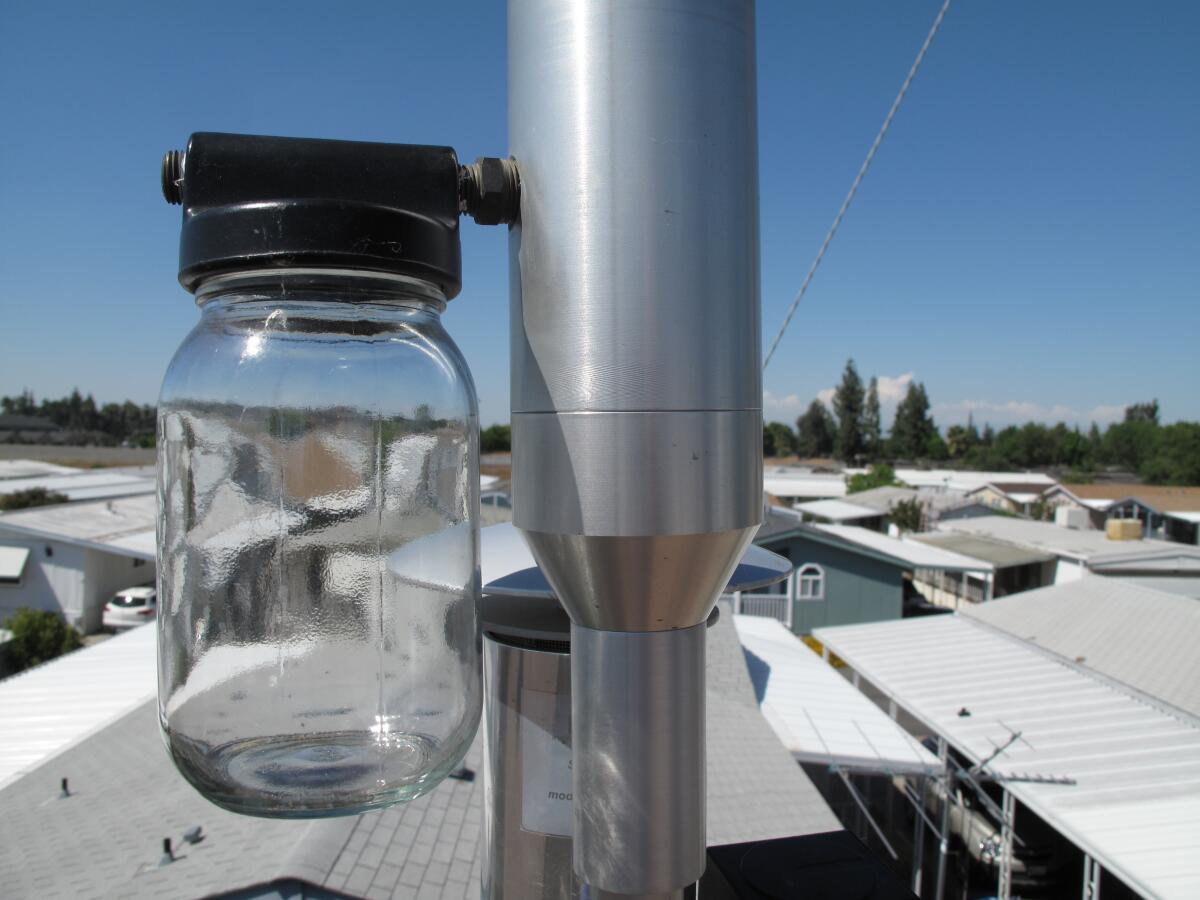
Since that episode in the early 1990s, Molina felt conflicted about advising pediatric patients to play outside for exercise, wondering how much the region’s poor air quality was to blame for the highest childhood asthma rates in the state. He wondered how much pollution contributed to premature births that were a regular occurrence at the hospitals he worked in. And when he suffered chest pains and eventually developed heart disease at 49, he wondered how much of a toll pollution had taken on him, too.
While Molina, who retired in 2013, has seen progress in cleaning vehicle emissions, he said agricultural burning remains a major contributor to pollution, despite a law banning it in 2003. At a state Air Resources Board meeting last year, Molina implored the state to end the practice, even if it meant providing more financial assistance to farmers.
Agricultural burning has proved very difficult to stop, however, particularly in times of drought.
In recent years, most of the emissions from agricultural burning have come from vineyards. In 2021, the most recent data available, vineyards accounted for 65% of all agricultural burning.
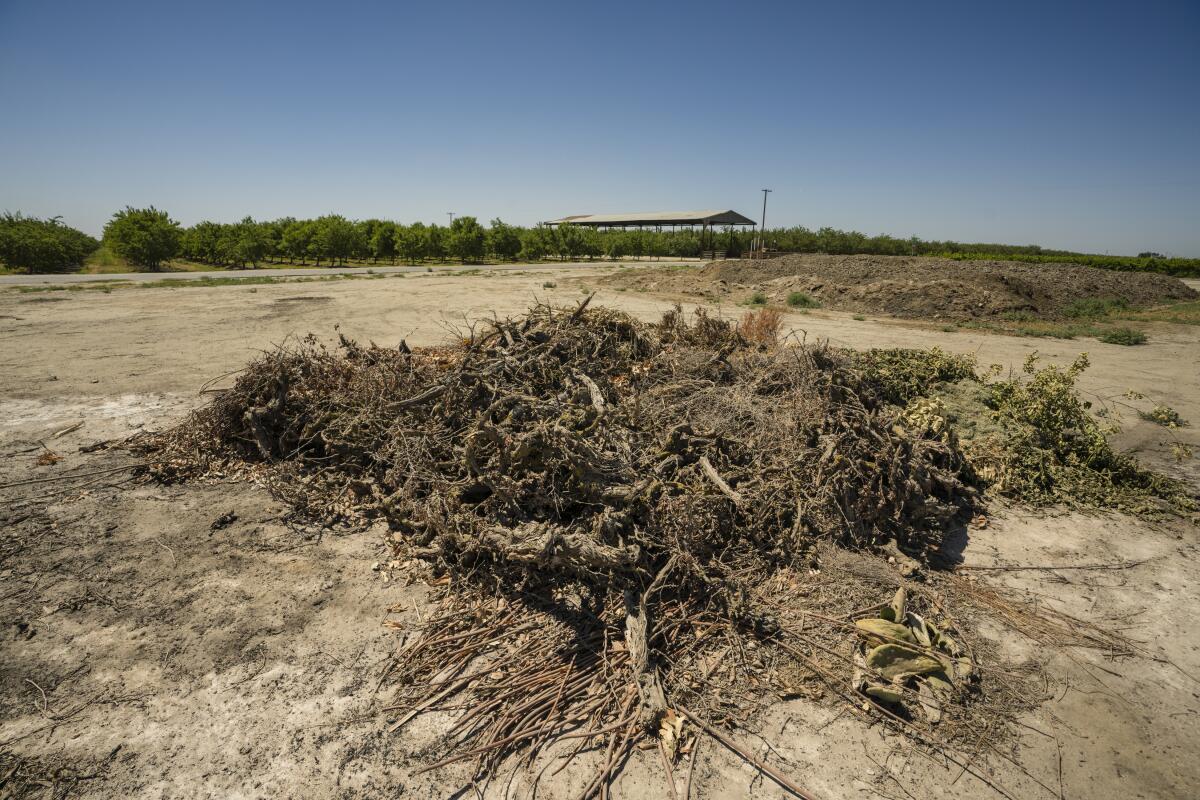
Jeff Bitter, president of Allied Grape Growers, said removals and burning have increased due to financial hardship within the grape industry. Recent droughts, Bitter said, have coincided with a seismic shift in consumer preference. A number of California grape products, including varieties of raisins and table grapes, have fallen out of demand.
“What you see in those vineyard numbers was largely due to that shift in the raisin industry,” Bitter said. “That same thing can also be said about table grapes, because that was another industry that was very highly dependent on the Thompson seedless variety, which became out of favor in consumers’ minds.”
In the early 2000s, more than a million tons of agricultural waste was burned in the San Joaquin Valley every year, according to the California Air Resources Board. Hundreds of thousands more were burned at biomass power plants, which were often criticized by environmental groups for emitting pollution and attracting truck traffic.
Officials appealed to farmers to use wood-chipping equipment to convert dead crops to mulch. Many were deterred by the expense, however. It costs about $500 an acre to burn crops, but more than $1,000 an acre to chip and shred them.
In 2003, state Sen. Dean Florez, a Democrat from Shafter, introduced a bill that would phase out agricultural burning by 2010. When Gov. Gray Davis signed it into law, he said he hoped it would curtail air pollution in a region vexed by “air that’s easier to see than it is to breathe.”
Initially, the new law appeared to work. By 2011, the amount of agricultural waste burned in fields had dropped roughly 80%.
But, as California entered a historic drought and large swaths of farmland were taken out of production, the trend dramatically reversed. By 2017, the amount of burned agricultural waste had more than tripled, peaking at 900,000 tons. At the same time, biomass power plants were shuttered, perhaps resulting in more field burning.
Due to drought and economic factors, the San Joaquin Valley Air Pollution Control District has repeatedly sought permission from the state Air Resources Board to extend the deadline for an end to agricultural burning. Under the state’s most recent plan, the air district has laid out a timeline of burning restrictions that it hopes will virtually end the practice by 2025. That now seems unlikely to occur during a worsening drought.
“Increased removal of orchards and vineyards will add strain to already existing difficulties faced in implementing this aggressive open burning phase-out strategy,” said Jaime Holt, spokesperson for the San Joaquin Valley air district. “And of course all of this is happening at the same time the region is experiencing worsening air quality impacts due to increasingly severe wildfires.”
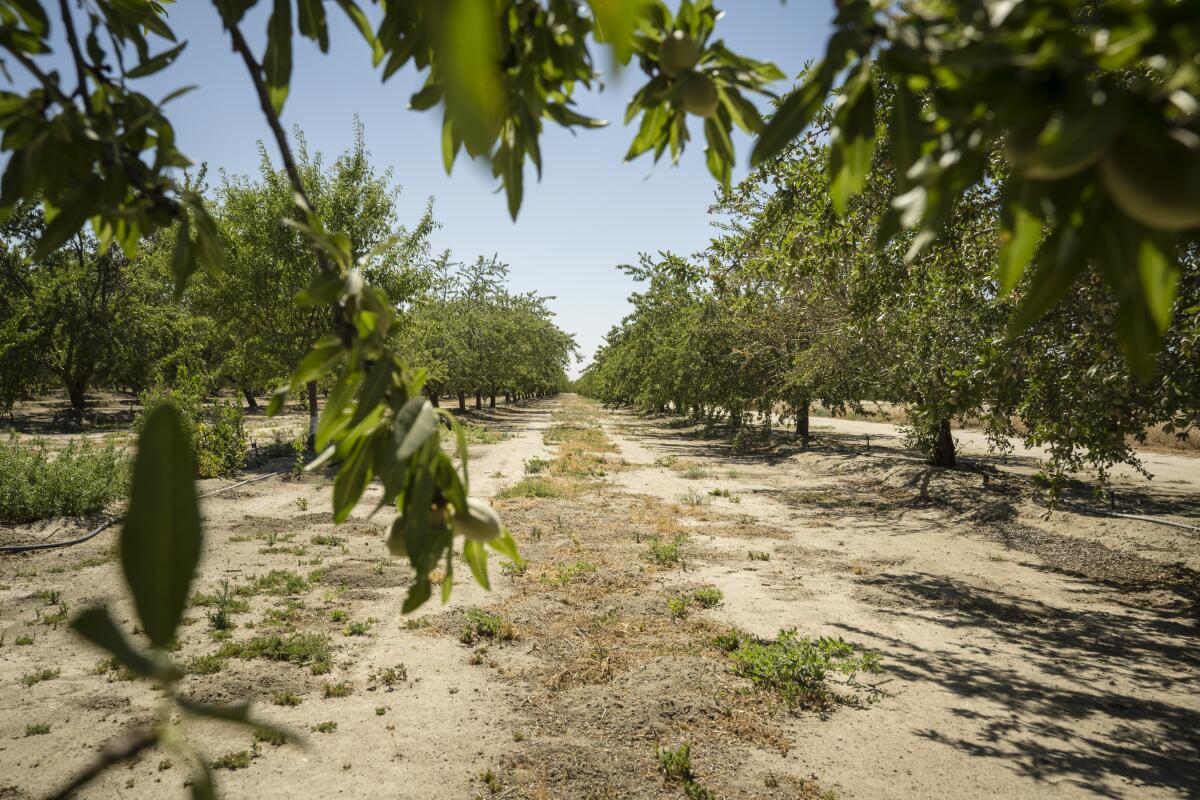
In August 2021, the San Joaquin Valley air district accepted $178 million in new state funding to incentivize alternative methods of managing ag waste, including grants to repurpose dead or abandoned crops into mulch. However, some say more needs to be done if the valley is to end burning in the next three years.
“The rate that permits are decreasing — it’s definitely not going to reach zero by 2025,” said Myla Kahn, a UC Berkeley environmental engineering student who has conducted research on the problem. “Big changes will be needed to meet that deadline.”
Christine Gemperle, a second-generation almond farmer, was a recent recipient of a mulching grant. She and her brother have operated two orchards since 1998 and were forced to make tough choices during the current drought.
“We had to let go and let die,” she said.
Stanford researchers examined how land is sinking in the San Joaquin Valley, finding that slowing or halting subsidence requires rising water levels.
With too little water to irrigate the almond orchard in Gustine, they faced the choice of either buying water “at a stupid price” and losing money, or uprooting an older orchard a year ahead of schedule.
She hired a crew to excavate the trees, let them dry out for several weeks and eventually run them through a tub grinder that converts the orchard into large mounds of wood chips that are reincorporated as mulch on her property. The process definitely has benefits, she said.
“We have a lot of really sandy soils in the valley, so water goes through them very quickly,” Gemperle said. “But when you recycle your orchard, you can change your soil. It increases your water holding capacity by up to 20%, and that’s a really big deal. Your trees may go through times where you don’t have water. But they’re more resilient once you’ve done the whole orchard recycling.”
But she said there are still some instances in which she thinks farmers have no choice but to burn. During the course of a year, fallen tree limbs or downed trees accumulate on farms. However, there aren’t smaller-scale and more affordable wood-chipping programs.
Uprooting a vineyard and disposing of the vines can be particularly challenging. Vineyards are an assembly of wooden stakes and metal guy wires that grapevines cling to. When grape growers decide to remove acreage, they must disassemble the trellis and manually cut a tangle of vines from the wiring.
Efforts are underway to rebuild Greenville, Calif., from the ashes of the Dixie fire. Can it be made to survive the next wildfire?
“It’s very challenging because there’s no easy way to dismantle a vineyard,” Bitter said. “You have to do it by hand. You have to hire people and have them take it apart and you have to bring in these big million-dollar machines to process the waste, and that’s why people have burned vineyards for so long at the end of their useful life. Because it’s just the most practical way to deal with the agricultural waste — the most economic way.”
While the challenges for farmers are largely financial, residents who live within these communities say it’s also a matter of public health.
“We’ve actually had community members describe smoke getting into their house and being so thick they called the fire department, because they didn’t know if there was a fire near them or what was generating so much smoke,” said Garoupa White, of the valley air coalition. “As you can imagine, people get stinging eyes, coughing, burning lungs and throat.”
What’s more, these fires often occur without warning, leaving communities with little preparation when they are overwhelmed with smoky air and falling ash.
Environmental groups have also called on the air district to publish online when agricultural burns are scheduled so that communities can protect themselves. It’s a request that has been repeatedly turned down.
The air district has said its policy on agricultural burns is the strictest in the nation. Most burning happens after the harvest, between late fall and spring. And to lessen the impact on public health, the air district only allows agricultural burns on good air quality days.
Nayamin Martinez, director of the Central California Environmental Justice Network, said the logic behind that rule is counterintuitive.
“Imagine what happens when you have a good air quality day and then they start giving all these permits to these farmers,” Martinez said. “Do you think we will still continue to have good air quality days?”

Aguayo, the La Vina resident, has called on the air district and other government agencies to establish buffer zones between farmland and sensitive areas, such as homes or schools. They hoped this might put some distance between where people are and areas where agricultural waste is being burned and pesticides are applied.
At the very least, she said, the air district could require growers near these sites to grind up their grapevines or orchards.
Recently, as Aguayo drove to Madera, she saw flames in an irrigation canal filled with dry weeds.
“It just sends the message that they’re not thinking about us as community members,” she said. “They’re just burning.”
